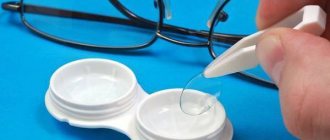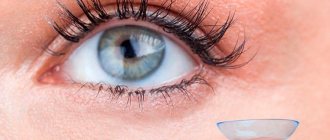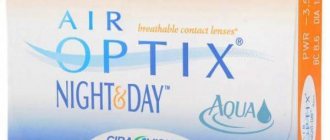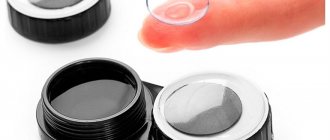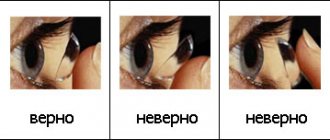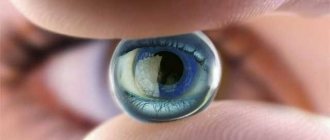The development of modern technologies allows us to improve materials for the manufacture of contact lenses. Now there are extended-wear models that can be worn for a long time without harm to the eyes. Let's look at how to properly use these optical products and get acquainted with their main features.
Long-lasting contact lenses are vision correction products that can be worn for 7 days and 6 nights without removal. There are also silicone hydrogel models designed for continuous use for up to 30 days.
This is incredibly convenient for those who travel, lead an active lifestyle, have a rotating schedule or work in emergency situations. In addition, such products are most effective for people who require systematic vision correction: with severe refractive error (farsightedness/myopia or astigmatism).
Extended lenses are an ideal solution for those who do not always have the opportunity to thoroughly clean and change optical products due to any circumstances.
Features of prolonged lens wearing
Most contact lenses are used during the day. This means that they are put on in the morning and taken off in the evening. One-day models are disposed of after removal. Ophthalmic products for routine replacement are treated with a disinfectant solution and placed in a special container for storage until next use. Daytime is not the only way to use contact optics. It can also be worn in flexible, extended and continuous modes. In the first case, you can leave the lenses on your eyes for a day or two: you can even fall asleep in them for one night. A prolonged regimen is wearing ophthalmic products for a week. All this time, the user can sleep in them without worrying that they will harm the health of the eyes. Continuous mode lenses can be worn for up to 30 days without removal. There are not many such models on the market. There are also nighttime orthokeratology lenses. I put them on before bed and take them off in the morning. Such optics belong to a completely different type and method of contact vision correction.
Lenses that can be used over time are very popular. They cost less than disposable ones, being an excellent alternative to them. Imagine that you are visiting and did not take lens care products with you. With extended-release ophthalmic products, you can go to sleep peacefully. In the morning you will not feel any discomfort. This type of contact optics is perfect for people who travel frequently. It is convenient and practical to purchase them before your vacation. Let's take a closer look at the characteristics and key features of lenses that can be worn over an extended period of time.
In what cases should they be used?
Extended wear contact lenses are suitable for many people. So, for example, for long-distance drivers, such lenses are simply irreplaceable because drivers spend quite a long time on the road, and they do not have the opportunity to take off and put on lenses every day.
Long-term wear lenses are also suitable for those who do not want to complicate their life and waste time on daily manipulations with lenses.
Long-lasting lenses can be used by people who go on long trips. This type of lens is recommended to be worn for certain reasons, such as therapy and after surgery as a bandage.
What do you need to know about such lenses?
What parameters should lenses with extended mode have? The main one is the level of oxygen permeability. The eyes receive nutrients along with oxygen. It penetrates the tissue of the eyeball through the blood vessels. However, the cornea is devoid of capillaries. It receives nutrition directly from the external environment. Lenses limit oxygen access to the cornea. Therefore, it is necessary to select models with a high gas permeability index (denoted Dk/t or DKL). This way, the eyes will be able to receive the required amount of oxygen at any time. At night, the cornea may be especially starved of it, since the eyes are still covered with eyelids. Long-life lenses must take all these factors into account. Even during sleep, the cornea will “breathe” in them.
If the cornea does not receive oxygen from the air, the risk of developing hypoxia—oxygen starvation—increases. If it occurs frequently, the vessels in the eyeball will begin to grow to provide nutrition to the cornea from the inside. This can lead to severe eye diseases.
Long-life lenses usually have a high moisture content. You don’t need to get used to them, they do not cause discomfort in the form of dryness and irritation. In the morning, a person should wake up with a feeling of freshness in the eyes, despite the fact that he slept in the lenses.
Another important parameter is the thickness of the ophthalmic product. As a rule, models that can be worn over an extended period of time have an ultra-thin and ultra-smooth structure. Modern silicone hydrogel lenses are equipped with all these parameters. Silicone allows oxygen to pass through well, and the hydrogel provides moisture to the cornea.
Risks and complications
Complications when wearing extended-release lenses are quite rare, but all of them require immediate treatment and consultation with an ophthalmologist.
- Redness of the eyes. This complication does not always mean the development of the disease. Redness appears during allergic reactions, inflammatory and infectious processes. Redness may mean that the eyes are not getting enough oxygen. It can also appear due to mechanical damage.
- Oxygen starvation of the cornea. Whatever the lenses, they in any case do not allow the eyes to consume enough oxygen. An acute degree of lack of oxygen can lead to swelling and blurred vision.
- Allergic and inflammatory reactions. The most common complication of wearing lenses is papillary conjunctivitis in adults. It develops in three percent of long-wear lens wearers. Conjunctivitis occurs due to the accumulation of protein and fatty deposits on the lens. The reasons for the development of conjunctivitis can also be: untimely replacement of lenses, improper hygiene. In addition to papillary conjunctivitis, allergic, lumbar conjunctivitis, and sterile keratitis can occur.
- Mechanical impact. Contact lenses can damage the cornea of the eye. This situation can arise when wearing lenses for a long time, or when removing and putting them on incorrectly. This complication may occur as a result of small particles getting under the lens, rupture, or uneven structure of the lens. With prolonged mechanical exposure, erosion may occur, which will be accompanied by symptoms such as a reaction to light, excessive lacrimation, and blurred vision. If an infection gets into the eye, ulcers and perforations may appear.
- Corneal deformation. It occurs when wearing lenses for a long time. If you stop using contact lenses for a while, the cornea will recover.
- Dry eyes. Contact lenses cover the corneal tissue and surrounding surface. This leads to the fact that the eyes do not receive enough nutrition and the composition of the tear film changes. In addition to dryness, redness or excessive tearing, burning and pain, and discomfort appear.
- Keratitis caused by infections. Infectious diseases can arise as a result of neglecting the service life of contact lenses. Keratitis is accompanied by dry eyes, excessive tearing, reaction to light, blurred vision, and the appearance of purulent discharge. Infectious keratitis occurs as a result of using dirty water for washing, swimming in ponds without removing lenses.
To reduce the risk of complications, it is recommended to remove long-wear lenses before going to bed and before swimming. Be sure to wash your hands before putting on and taking off your lenses. Compliance with the advice of an ophthalmologist and the requirements of the instructions will also minimize the occurrence of complications.
Popular extended wear lenses
Which silicone hydrogel ophthalmic products should a buyer choose? The range of such products is quite large. We list the models that are in maximum demand:
- PremiO from Menicon. These lenses have a gas permeability parameter of 161 Dk/t. Moreover, they consist of 40% water. The model is designed for two weeks of use and is intended for the correction of farsightedness and myopia.
- PureVision 2 HD from Bausch + Lomb are monthly “high definition” lenses. They have an aspherical design and are available with a wide range of diopters to correct myopia and hypermetropia of all degrees. The DCL indicator is 130, and the moisture content is 30%.
- Air Optix® Aqua from Alcon. This model is made from Lotrafilcon B, which allows up to 110 units of oxygen to pass through. These ophthalmic products also correct farsightedness and nearsightedness.
- Ochkov.Net Sport Formula from Ochkov.Net. This contact optics guarantees clear vision even in severe forms of visual pathologies. The lens design is aspherical. This model is perfect for those who spend a lot of time driving.
In our online store you can purchase the presented and other lenses with extended mode.
Tips for choosing lenses
The selection of lenses is carried out in the ophthalmologist's office. Sign up for a pre-purchase inspection. Extended wearing of contact optics must also be approved by a physician. People with hypersensitive eyes should only wear ophthalmic products during the day. Disposable models are most suitable for them. If the ophthalmologist does not find any contraindications, you will be able to use contact optics for a prolonged period. During the examination, all the necessary parameters will be determined, after which the specialist will write a prescription. With it you can go to the optical salon. You will find a large selection of lenses on our website.
Their advantages
The advantages of extended-release contact lenses are as follows:
- Good oxygen permeability, which ensures the “breathing” of the eyes.
- Suitable for sensitive eyes.
- There is no need for daily lens disinfection procedures.
- Comfortable and safe to wear.
Long-term wear lenses will be simply indispensable for people leading an active lifestyle. They are also suitable for people with visual impairments who need constant correction due to diseases, with a very high degree of myopia, farsightedness, and astigmatism.
Tips for caring for lenses
Care for contact optics, if they are used for more than one day, is carried out daily after removal. If the lenses are not cleaned and disinfected, they will quickly lose their optical properties, become cloudy, and will have to be thrown away. In addition, you can get an infection in your eyes. Silicone hydrogel ophthalmic products are best treated with multifunctional and universal solutions. They are suitable for all types of lenses. With the help of such products, you can carry out a full cycle of care: cleaning, disinfecting, rinsing and storing contact optics. Many solutions also have a moisturizing effect. Pay attention to the following cleaning fluids: Comfort Vue, Pro Active, Maxima (universal) and Biotrue, Opti-Free, High Fresh+ (multi-purpose). Don't forget about containers for storing lenses. They must also be kept perfectly clean. They must be changed at least once every 3 months.
